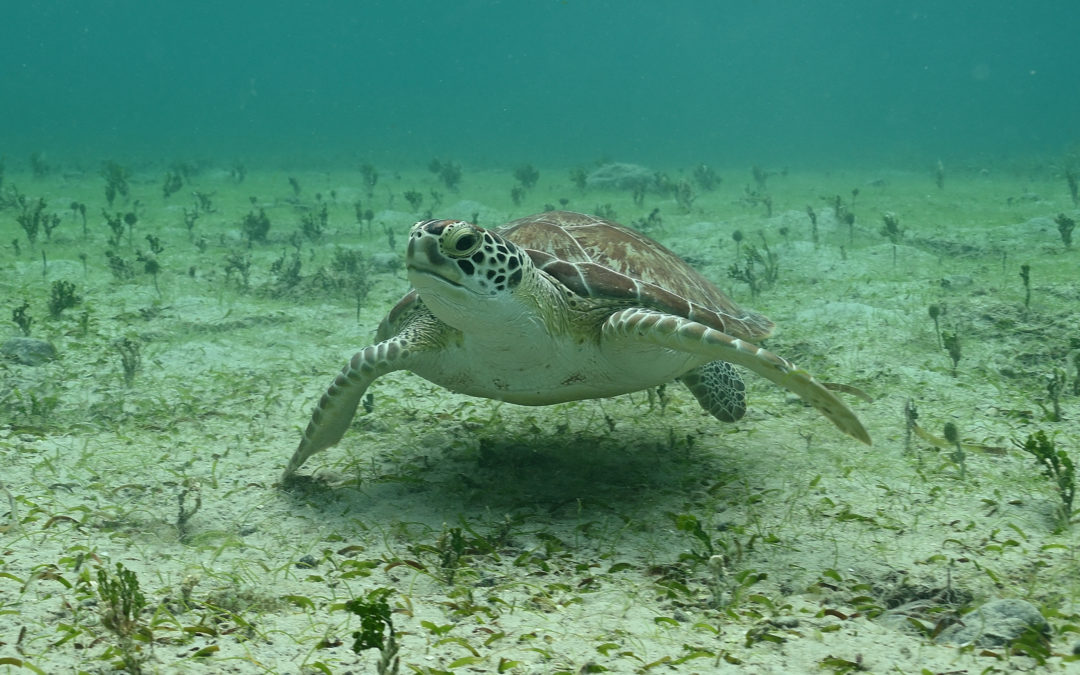Sea Turtle Migration: Moms on the Move!
By Jessica Stuczynski, Biological Science Technician
May 1 kicked off the sea turtle nesting season at Cape Hatteras National Seashore (Seashore)! Every morning, biological technicians hit the beach to survey and document new sea turtle activity from the night prior on Seashore beaches.
We often hear about sea turtles during the nesting season (which runs from May – September in North Carolina), but where do sea turtles go after the nesting season ends?
Sea turtles reside in coastal waters during the nesting season and will typically make multiple nesting attempts on beaches at roughly two-week intervals. After their final nesting attempt, however, these moms are on the move! Sea turtles are a highly migratory species, often migrating hundreds to thousands of kilometers from their nesting grounds to foraging grounds where they take up residence to feed and find refuge until the next reproductive cycle. This “remigration interval” typically ranges from two to four years on average but can vary by individual. At these resident foraging grounds, sea turtles must build up energy stores in preparation for the next nesting season and the costs associated with migrating back to coastal breeding sites. Sea turtles display strong nest site fidelity, often returning to the same beaches on which they were born to nest as adults. Interestingly, the same nesting grounds aren’t the only locations sea turtles habitually return to — they also return to the same foraging grounds
Why do turtles return to the same foraging grounds after each breeding season?
Studies have shown that sea turtles will pass by perfectly suitable habitat in route to their resident foraging grounds. How can this be advantageous to sea turtles? One benefit of foraging site fidelity is predictability. Individuals would have previous knowledge of the area and know that they can survive in the area for long periods of time. In the Caribbean, Green sea turtles have been observed cropping the same seagrass plots in nutrient limited areas which promotes faster regrowth. By grazing on the same plots over and over again, they are contributing to their own food security!
Migrating back to the same foraging site, even if this foraging site is far away, may also reduce competition among individuals for resources. Perhaps the quality of the foraging habitat outweighs the swimming distance. Maybe there are fewer predators in the area. Despite the reasoning as to why some turtles travel farther than others, research has shown that the productivity of these foraging sites is crucial as some turtles do not feed during breeding seasons; thus, they must acquire enough energy at their foraging grounds to sustain them for both the migration back to their nesting grounds and the energetic costs associated with nesting on the beach.
How do we know where sea turtles are moving?
A combination of methods! Traditionally, flipper tags or PIT tags (like tags or chips used for domesticated animals) have been used as a common tracking tool to determine sea turtle movement. These tags, however, only provide start and end points for movement when individual turtles are recaptured – they don’t provide information of the movement between these two locations. Satellite telemetry is another research tool used by scientists to understand movement patterns. These tracking devices can be attached to the carapace of a sea turtle. Every time the turtle surfaces to breathe, the device transmits data on geographic location to a satellite receiver overhead. Successful transmissions are relayed from the satellites to receiving stations on the ground where the data are processed and provided to researchers. This information can reveal migration patterns and information related to breeding and foraging grounds. Some transmitters can also record information such as water temperature, diving behavior, and swimming speed!
Why is knowing where sea turtles move important?
Adult sea turtles spend most of their lives at foraging grounds or migrating between foraging grounds and breeding sites. Knowing the location and timing of turtles on the move can help managers determine where and when these animals are most vulnerable. Identifying migration corridors and turtle hotspots can help reduce negative interactions (such as encounters with vessels and fisheries) and help inform the designation of protected areas.
How can you help sea turtles on the move?
- Go slow, sea turtles below! Designate a proper “lookout” while boating to help spot sea turtles and avoid collisions.
- Avoid anchoring vessels in critical sea turtle habitat such as seagrass beds.
- Properly dispose of trash. Sea turtles may mistake trash, such as clear plastic bags, as a food item (like a jellyfish!).
- Don’t release your helium balloons! They can easily be ingested by sea turtles and/or become an entanglement hazard.
- Never abandon fishing gear. Hooks, lines, and nets can easily entangle and harm sea turtles.
About Jessica:
Jessica Stuczynski is a Biological Science Technician (Marine Resources) at Dry Tortugas National Park, located 70 miles west of Key West, Florida. She is on a temporary detail at Cape Hatteras National Seashore in the Division of Resource Management through mid-June. Jess’s work with the National Park Service (NPS) focuses on sea turtle and shorebird monitoring, exotic/invasive management, and coral reef monitoring and restoration efforts. She has been with the NPS for 3.5 years.
Photo: A green sea turtle (Chelonia mydas) resting in a seagrass bed. Photo by Michael Schilling.


The Dry Tortugas National Park was the high light of our vacation to Key West. Thanks for your work there and here. Hatteras Island is our permanent retirement home. You must find great pleasure in your work environment, never working a day in your life!